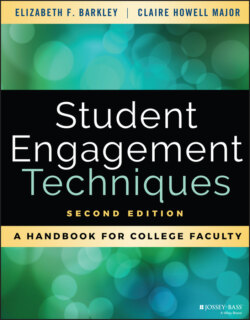Читать книгу Student Engagement Techniques - Elizabeth F. Barkley - Страница 61
Condition 3: Teachers Can Create Synergy by Teaching so That Students Learn Holistically
ОглавлениеAs college professors, we flourish in the “thinking” world. When we consider college-level learning, we readily understand and value the acquisition, synthesis, and evaluation of knowledge that characterizes abstract thought. Bloom's taxonomy of the cognitive domain, which classifies behaviors such as these into a series of hierarchical levels, has served as a guide to faculty in all kinds of institutions as they design and develop their courses. But learning involves more than rational thinking. Even the definition of cognition itself moves beyond pure intellectual reasoning to include processes such as intuition and perception. Furthermore, new models of “intelligence”—such as Gardner's “multiple intelligences” (which contains a bodily-kinesthetic component) and Goleman's “emotional intelligence” (which emphasizes the ability to monitor one's own and other's feelings)—challenge us to embrace a concept of learning that extends beyond logical thinking.
This broader, more inclusive perspective is also supported by neuroscience. Harvard clinical psychologist John Ratey (2002) observes that the “new view” is that brain and body systems are distributed over the whole person and that we cannot separate emotion, cognition, and the physical body. In fact, separating these functions “is rapidly coming to be seen as ridiculous” (p. 223). Thus, despite higher education's historical emphasis on the purely intellectual, many educators today recognize that the body, heart, and mind are all involved in learning, and that all three make contributions to engagement. Some individuals, such as McTighe and Wiggins (1999a), Shulman (2002), and Fink (2003), are suggesting new taxonomies that integrate multiple domains.
